Technocrane
The Technocrane is a telescopic camera crane and a revolutionary invention that has transformed the film industry and television production worldwide.
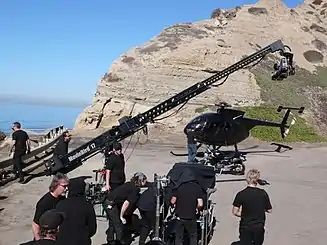
The Technocrane allows the camera to be moved in any direction without moving the base of the crane. This gives the filmmakers more flexibility and creativity in capturing dynamic shots and angles.
The Technocrane can also extend and retract its arm smoothly and quietly, thanks to a counterweight system that keeps the crane balanced. The Technocrane is a game-changer that has opened up new possibilities and challenges for the art of cinematography.
Initial Technocranes were made by Technovision. Today derivates are available from several manufacturers such as SuperTechno, MovieBird and Servicevision amongst others. Technocranes are available in many different sizes and with various specifications, from 10 feet (3.0 m) to 75 feet (23 m) reach.
The Technocrane can operate in different lengths and can be equipped with various remote heads, including stabilised ones, to suit different needs and preferences. The camera is mounted on the remote head on the end of the crane and is remote controlled by a camera operator at a control desk.
The Technocrane can telescope at variable speeds of up to 2.5m/s on demand. It allows camera moves that cannot be achieved using a jib arm or a camera dolly,[2] and the telescoping can be used to compensate for the camera moving in an arc called "arc compensation".[3]
History
Originally commissioned, manufactured, named and marketed by Technovision Ltd. in London, United Kingdom, the first TechnoCrane was exhibited by Technovision during Photokina Expo in Cologne, Germany in September 1986.
The first Technocrane related U.S. Patent #4943019 was granted to Gyula Mester/Technovision and filed in 1988 by the US Patent Office.
The Technocrane was first introduced to Hollywood in the late 1980s by one of the Technovision trained crane technicians, Simon Jayes.
In 1999, the Society of Camera Operators (S.O.C.) presented their technical achievement award to Technovision, Gyula Mester and Keith Edwards for the "First Telescopic Camera Crane" and for their significant contributions to the Art, Craft and Safety of the Camera Operator.
In 2005, at the 77th annual ceremony the Academy of Motion Picture Arts and Sciences presented Academy Awards to Horst Burbulla, Gyula Mester and Keith Edwards for the invention and development of the Technocrane.[4][5][6]
Usage
Productions that have used the Technocrane or the later SuperTechnocrane include Titanic, the Harry Potter films, the Lord of the Rings films, and all the James Bond films of the late 1990s and 2000s, among many others.
Gallery
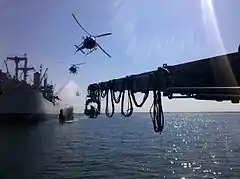 Technocrane used during the filming of X-Men: First Class (2011)
Technocrane used during the filming of X-Men: First Class (2011)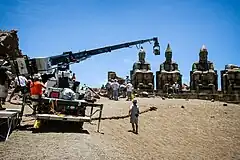 Technocrane rental from ALPHA GRIP in production
Technocrane rental from ALPHA GRIP in production Technocrane derivative Moviebird, a 52 foot telescopic camera crane with a camera remote head at a live TV show in Norway
Technocrane derivative Moviebird, a 52 foot telescopic camera crane with a camera remote head at a live TV show in Norway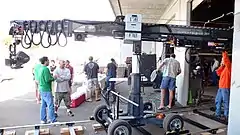 SuperTechno 30
SuperTechno 30 MovieBird 45 (45 feet (14 m))
MovieBird 45 (45 feet (14 m))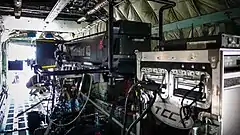 MovieBird Crane mounted inside airplane
MovieBird Crane mounted inside airplane Technocrane used during the filming of Ghost Protocol
Technocrane used during the filming of Ghost Protocol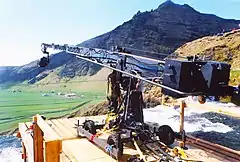 SuperTechnoCrane commercial shoot in Iceland 1998
SuperTechnoCrane commercial shoot in Iceland 1998
See also
References
- "Donna Feldman for Visa Black Card". LUXUO. 2010-04-16. Retrieved 2022-05-13.
- Cury, Ivan (2005). TV commercials: how to make them, or, how big is the boat?. Elsevier. pp. 235. ISBN 0-240-80592-5.
- Brown, Blaine (2002). Cinematography: Theory and Practice: Image making for Cinematographers. Focal Press. p. 303. ISBN 0-240-80500-3.
- "Makers of Cranes, Illusions take home first Oscars". New Zealand Herald. Reuters. 2005-02-15. Retrieved 2009-11-14.
- Hewitt, Charles (February 2001). "Crane Wars". Eyepiece.
- Laufenberg, Norbert B. (2005). Entertainment Celebrities. Trafford Publishing. p. 888. ISBN 1-4120-5335-8.
External links
- 1st Technocrane related Patent - 1988 - by Gyula Mester / Technovision
- Maker of MovieBird telescopic cranes
- Maker of SuperTechno
- Maker of the Scorpio cranes